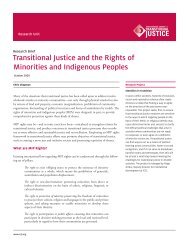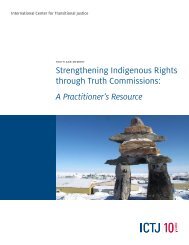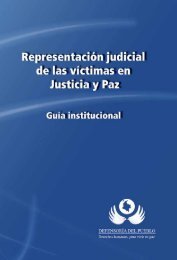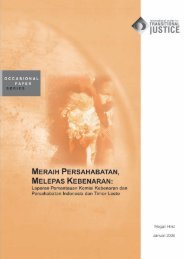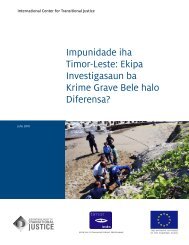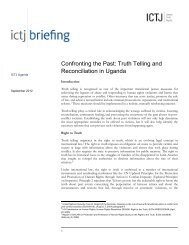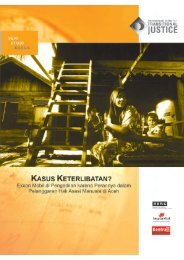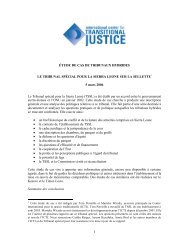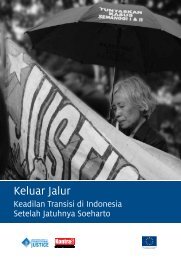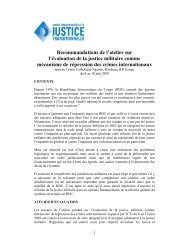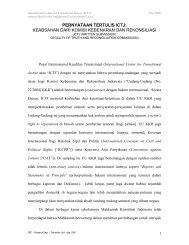That Someone Guilty Be Punished - International Center for ...
That Someone Guilty Be Punished - International Center for ...
That Someone Guilty Be Punished - International Center for ...
Create successful ePaper yourself
Turn your PDF publications into a flip-book with our unique Google optimized e-Paper software.
groups are approximately the same size. 80 In exchange <strong>for</strong> considerable autonomy in RS, the<br />
Serbs accepted in principle what they had <strong>for</strong> three and a half years fought against—a Bosnian<br />
State that included RS.<br />
The Bosnian government found one aspect of the territorial division particularly hard to<br />
accept in Dayton: Srebrenica would remain under Serb control. Twelve years later, when the<br />
<strong>International</strong> Court of Justice ruled that the Serb assault on Srebrenica was a genocide, some<br />
Bosniak leaders urged that Srebrenica be wrested from RS. In their view, to maintain Serb<br />
control over an area they had acquired through genocide was morally indefensible. 81<br />
This issue was emblematic of a broader moral quandary at the heart of Dayton: Although<br />
Serbs were awarded final control over less territory than that which they had acquired in war<br />
(roughly 70 percent of Bosnian territory), the Serb entity by its nature seemed to ratify the<br />
results of “ethnic cleansing.” To avoid this, Dayton assures all Bosnians the right to return to<br />
their original homes. In Chapter IV, we address the question of whether and how arrests of<br />
ICTY suspects might have affected implementation of this right.<br />
The DPA also created an international governing structure, the Office of the High Representative<br />
(OHR), that would be responsible <strong>for</strong> implementing the civilian provisions of the<br />
peace accords. The OHR, acting under the authority of the Peace Implementation Council,<br />
an international body guiding the peace process in Bosnia, 82 now also represents the European<br />
Union. 83 Initially envisaged as a transitional structure that could be withdrawn when<br />
the previously warring factions reconstructed a national government, the OHR mandate was<br />
strengthened in 199784 and has been repeatedly extended in the face of strong ethnic division<br />
in Bosnia. 85<br />
E. The Post Dayton Peace<br />
The history of post-Dayton Bosnia could have been very different if Karadžić and Mladić had<br />
been brought to trial in The Hague. 86<br />
Although IFOR was authorized to arrest individuals indicted by the ICTY and provide support<br />
<strong>for</strong> other aspects of the civilian dimensions of the DPA, its commander resolved to avoid any<br />
such missions, however compelling the need. 87 Officially, NATO’s policy was that its Bosnia<br />
<strong>for</strong>ce would arrest those indicted by the ICTY if it came across them while carrying out its<br />
duties but would not seek out suspects. 88 Several months into the peace operation, a U.S.<br />
defense official told the New York Times: “We will take these people into custody if they surrender<br />
to us, preferably with their hands up over their heads, or maybe if they’re turned in<br />
by someone else.” But, he said, “I can’t imagine it would happen any other way … [W]e have<br />
a much bigger mission in Bosnia.” 89 In practice, IFOR went out of its way to avoid arresting<br />
suspects, reportedly waving Karadžić and other suspects through NATO checkpoints.<br />
28 BACKGROUND




